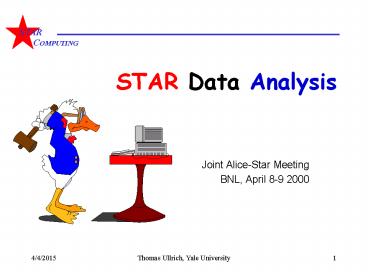STAR Data Analysis - PowerPoint PPT Presentation
Title:
STAR Data Analysis
Description:
Thomas Ullrich, Yale University. 2. STAR. COMPUTING. STAR Data Analysis ... Thomas Ullrich, Yale University. 9. STAR. COMPUTING. StEvent. Heavy use of abstract ... – PowerPoint PPT presentation
Number of Views:30
Avg rating:3.0/5.0
Title: STAR Data Analysis
1
STAR Data Analysis
- Joint Alice-Star Meeting
- BNL, April 8-9 2000
2
STAR Data Analysis
- Framework same for reconstruction analysis
- Analysis specific infrastructure is still
evolving - The how-to is clear - just has to get done
- Physics working groups PWGs actively develop code
which are - PWG specific analysis
- common simplify specific tasks, plotting, data
handling - Missing pieces are no show-stoppers (MDC3)
- Still we benefit from the fact that year1 is
simpler in many aspects
3
Components
- root4star, STARs ROOT framework
- Maker scheme, I/O Maker
- Persistent OO Datamodel StEvent
- Interface to simulated/embedded data StMcEvent
- Grand Challenge Apparatus, data mining
- Tag Database, data mining
- File Catalog
- Histogramming ROOT
- Visualization ROOT based, independent DSV
- Most components were written/implemented during
the last 2 years ? 100 C
4
Framework - How-to
- Macro doEvents.C
- arguments nevents, data files/data directories
- loads shared libs
- sets up chain I/O maker (StEventMaker)
AnalysisMaker - loops over events
- Class StAnalysisMaker
- contains the analysis code
- StMakerInit() book histos, ntuples
- StMakerMake() selection, cuts, combinatorics
etc. - compiled as shared lib loaded by doEvents.C
- Both exist as working examples - modified by
user/PWG - Simple scheme allows new users a quick start but
gives enough flexibility for complex tasks
(example)
5
xDST, x mini, ?, nano, ...
- Most urgent issue implemented soon, almost ready
- STAR rule miniDST STAR-wide defined
- usable by everyone
- Format/Classes defined within StEvent
- usually a subset of StEvent
- allows correlation with TagDB
- relaxed xDST where x ? ? can be user/pwg
specific - often simple ntuples/trees
- or self made
- or again a smaller subset of StEvent
6
(No Transcript)
7
StEvent
- Currently OO Datamodel for DST analysis
- Very soon StEvent directly written DST
- currently DST tables
- tables read in and used to fill/setup StEvent
(overhead) - Soon add PSD classes (provided by PWG)
- Slowly but steadily extend into reconstruction
- Slow because of FORTRAN legacy code
- essential components (TPC reco)
- global reconstruction must come next
- New code, e.g. EMC fills directly to StEvent
- Goal Become overall persistent datamodel for
reco analysis
8
StEvent
- Top class StEvent event header
- from here navigate to tracks, hits, trigger,
etc. - one single entry point
- components can be used independently
- StEvent inherits from St_DataSet
- All other classes inherit from StObject (TObject)
9
StEvent
- Heavy use of abstract interfaces
- track model
- Use of functors
- PID algorithm
- filters etc.
- sharing of functors between users (PID)
- Minimize dependencies
- Use of StarClassLibrary
- small foundation classes
- Steadily growing
- new EMC, L3
- to come RICH, TOF
10
StEvent
- All containers based on StArray
- STL interface
- Soon to work with STL algorithms
- Internally mapped to TObjectArray
- Distinguish structural/non-structural containers
- structural owns objects
- non structural only references objects
- Pointers can be stored as such
- class StPrimaryTrack
- //
- private
- StVertex mVertex //LINK
- //
- ClassDef(StPrimaryTrack,1)
11
C/STL/ Platforms
- StEvent uses STL where CINT doesnt see it
- STL is increasingly used in user code and
reconstruction code (user like it) - SUN/Solaris
- until recently CC4.2 ObjectSpace
- non-ANSI, lot of things missing, lousy all
together - new CC5
- ANSI/ISO StandardCLibrary
- lots of confusion for ROOT port uses old iostream
- still these damned warnings X is hiding Y
- Linux
- nice and easy
- STAR rule on Linux warnings error
12
MDC3
STAR-only exercise directed at physics analysis,
exercising physics analysis software, analysis
infrastructure and CAS tools and facilities.
- 2 weeks, short but well attended (50-60), 4 (5)
out of 6 PWGs - Physics-wise
- 1k - 50k event analyzed (150k produced)
- first time use of full set of tools
(efficiencies!) - lots of activities, meetings, discussions
- RCF-wise
- lousy 1st week, servers moved, RAID crashed, afs
gone, network bad - 2nd week more stable, data file corruption, LSF
configuration
13
Outlook
- Some components still implemented and exercised
on bigger scale - Grand Challenge, TagDB
- Embedding
- StEvent (ROOT) I/O
- Use MDC3 finding to increase pressure on RCF (has
to improve)
- Almost ready for year-1, still lots of work to do
- Less changes in year-2 (compared to
reconstruction) - Real test 1st run May/June - August 2000
Ask again _at_ Quark Matter, Jan 2001

